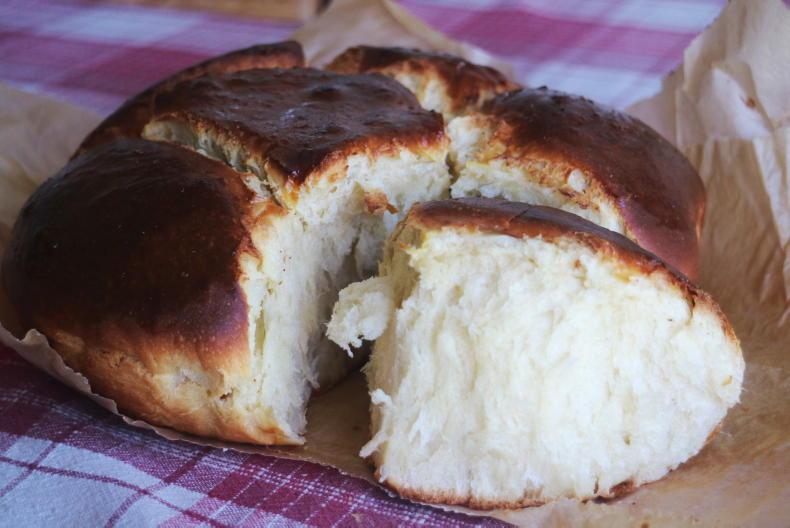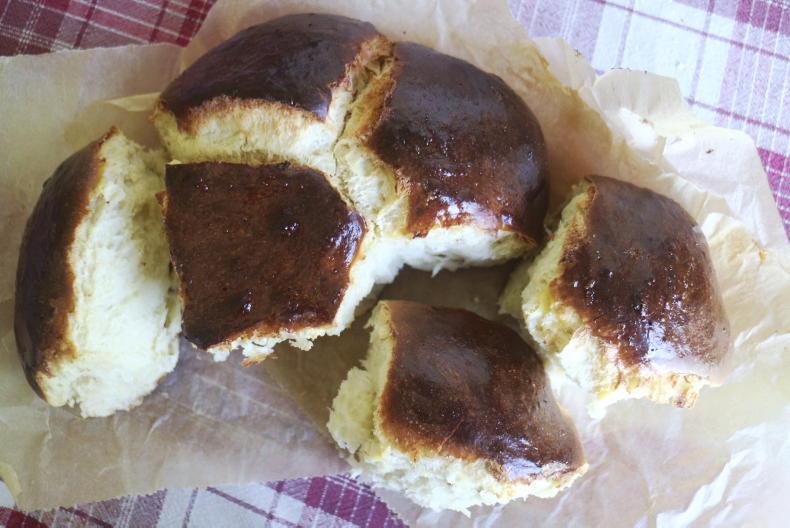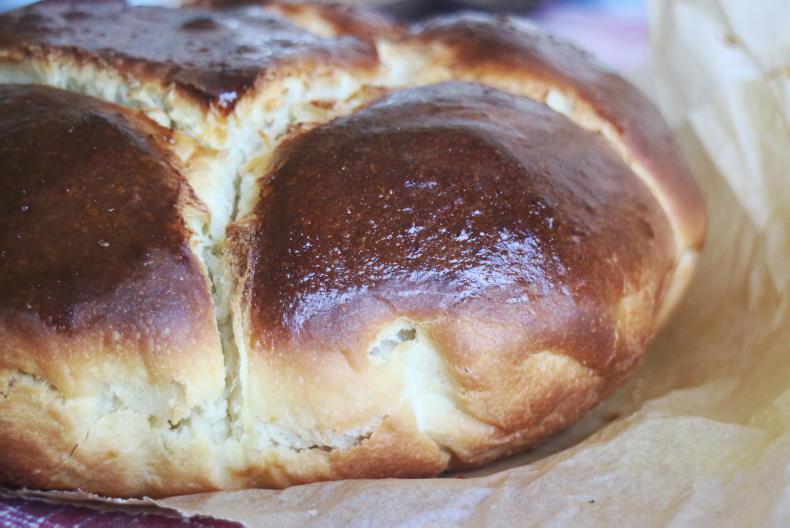I love homemade bread. Is there any better aroma than the smell of bread, fresh out of the oven?
The type of bread I crave always depends heavily on my mood, or what I feel like eating.
If I want toast, I usually go for a rustic sourdough (dripping in melted butter).
A sandwich? Batch loaf, for sure.
In Ireland your bread rolls are usually filled; comprising of a whole meal (a chicken fillet roll, for example).
Rolls
In Canada, and probably other parts of North America, a roll is something you have on the side of your dinner. Either with a chunky chowder, your Christmas turkey or fried chicken and coleslaw.
I love those bread rolls - they're soft and buttery; perfect for dipping into sauce and soups.
Equally, they're great for bread-based desserts and breakfasts.
These dinner rolls are made in a similar style to a French brioche, using sugar, yeast, butter and milk in the dough (we call this an enriched bread dough in the culinary world).
Because of this, they are slightly sweet, and they're the perfect bread for bread puddings or French toast.
You could even fill them with ice cream for a decadent ice cream sandwich or slather them with chocolate spread for an afternoon treat.

These bread rolls are multi-purpose - great for sweet or savoury dishes and can be used in a variety of ways. / Janine Kennedy
They also make excellent burger buns and sandwiches. They are truly multi-purpose.
Now, the dough does take two days to prepare. It's not 100% necessary, but I would recommend it.
You leave it out to rise for one hour, then transfer to the fridge overnight.
Then, the next day, it's a matter of bringing it back to room temperature, shaping into rolls and letting it rise once more before baking.
When dough has the chance to slow-ferment in a cold place, it develops its flavour.
So while you could simply let it rise twice a room temperature and bake it the same day, it will taste much better if you leave it overnight.

These bread rolls are multi-purpose - great for sweet or savoury dishes and can be used in a variety of ways. / Janine Kennedy
Makes six large rolls
Ingredients:
2 tsp yeast
2 tsp + 120g granulated sugar
30ml warm water
125g softened butter
100ml warm milk (I warmed mine in the microwave for 30 seconds, then added in the butter to cool it slightly)
2 tsp vanilla
2 eggs
2 tsp salt
400g bread flour (plain also works)
One egg, beaten, for brushing
Directions
1 Activate the yeast. In a large bowl, add the yeast, 2 tsp sugar and warm water. Let sit for 5 to 10 minutes as the yeast activates (it will grow and bubble when ready). 2 Warm your milk, then add the butter to it. This will lightly melt the butter and cool the milk as well, so it doesn't kill the yeast. Add the vanilla to the milk and butter and mix, then add to the yeast mixture.3 Add the eggs and remaining sugar and mix, then add the flour. 4 Knead the dough until smooth and elastic; at least 5 to 8 minutes (brioche is notoriously sticky, so I use a stand mixer with the hook attachment for this; if using your hands you can lightly dust with flour or simply knead it in the bowl).5 Cover the dough with a clean dish towel and let rest for one hour or 90 minutes. It should double in size by this time. Punch the dough down, re-shape into a ball, cover and refrigerate overnight.6 The next day, remove the dough from the fridge and let sit at room temperature or in a warm spot (I put mine in the hot press) for one hour. 7 Punch down and shape into six larger or 12 smaller balls. Place in a dish, either buttered or lined in parchment, and let rise once more for 30 to 45 minutes. Preheat the oven to 180C.8 Lightly brush the tops with beaten egg and bake in the preheated oven for 25 to 30 minutes, until dark golden brown on top. 9 Remove from the dish right away and let cool on a wire rack. Eat warm or keep in an airtight container for up to two days.
I love homemade bread. Is there any better aroma than the smell of bread, fresh out of the oven?
The type of bread I crave always depends heavily on my mood, or what I feel like eating.
If I want toast, I usually go for a rustic sourdough (dripping in melted butter).
A sandwich? Batch loaf, for sure.
In Ireland your bread rolls are usually filled; comprising of a whole meal (a chicken fillet roll, for example).
Rolls
In Canada, and probably other parts of North America, a roll is something you have on the side of your dinner. Either with a chunky chowder, your Christmas turkey or fried chicken and coleslaw.
I love those bread rolls - they're soft and buttery; perfect for dipping into sauce and soups.
Equally, they're great for bread-based desserts and breakfasts.
These dinner rolls are made in a similar style to a French brioche, using sugar, yeast, butter and milk in the dough (we call this an enriched bread dough in the culinary world).
Because of this, they are slightly sweet, and they're the perfect bread for bread puddings or French toast.
You could even fill them with ice cream for a decadent ice cream sandwich or slather them with chocolate spread for an afternoon treat.

These bread rolls are multi-purpose - great for sweet or savoury dishes and can be used in a variety of ways. / Janine Kennedy
They also make excellent burger buns and sandwiches. They are truly multi-purpose.
Now, the dough does take two days to prepare. It's not 100% necessary, but I would recommend it.
You leave it out to rise for one hour, then transfer to the fridge overnight.
Then, the next day, it's a matter of bringing it back to room temperature, shaping into rolls and letting it rise once more before baking.
When dough has the chance to slow-ferment in a cold place, it develops its flavour.
So while you could simply let it rise twice a room temperature and bake it the same day, it will taste much better if you leave it overnight.

These bread rolls are multi-purpose - great for sweet or savoury dishes and can be used in a variety of ways. / Janine Kennedy
Makes six large rolls
Ingredients:
2 tsp yeast
2 tsp + 120g granulated sugar
30ml warm water
125g softened butter
100ml warm milk (I warmed mine in the microwave for 30 seconds, then added in the butter to cool it slightly)
2 tsp vanilla
2 eggs
2 tsp salt
400g bread flour (plain also works)
One egg, beaten, for brushing
Directions
1 Activate the yeast. In a large bowl, add the yeast, 2 tsp sugar and warm water. Let sit for 5 to 10 minutes as the yeast activates (it will grow and bubble when ready). 2 Warm your milk, then add the butter to it. This will lightly melt the butter and cool the milk as well, so it doesn't kill the yeast. Add the vanilla to the milk and butter and mix, then add to the yeast mixture.3 Add the eggs and remaining sugar and mix, then add the flour. 4 Knead the dough until smooth and elastic; at least 5 to 8 minutes (brioche is notoriously sticky, so I use a stand mixer with the hook attachment for this; if using your hands you can lightly dust with flour or simply knead it in the bowl).5 Cover the dough with a clean dish towel and let rest for one hour or 90 minutes. It should double in size by this time. Punch the dough down, re-shape into a ball, cover and refrigerate overnight.6 The next day, remove the dough from the fridge and let sit at room temperature or in a warm spot (I put mine in the hot press) for one hour. 7 Punch down and shape into six larger or 12 smaller balls. Place in a dish, either buttered or lined in parchment, and let rise once more for 30 to 45 minutes. Preheat the oven to 180C.8 Lightly brush the tops with beaten egg and bake in the preheated oven for 25 to 30 minutes, until dark golden brown on top. 9 Remove from the dish right away and let cool on a wire rack. Eat warm or keep in an airtight container for up to two days. 







 This is a subscriber-only article
This is a subscriber-only article










SHARING OPTIONS: